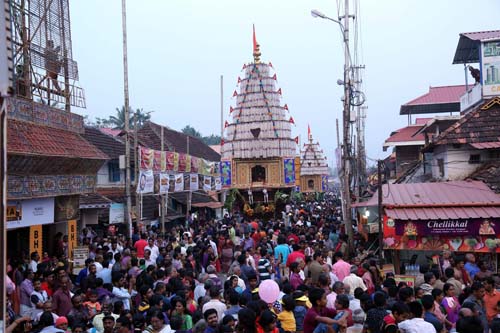The Day After Festival – Kalpathi Chariot Festival

The largest district in Kerala; the granary of Kerala; the birthplace of several artists like Chembai Vaidyanatha Bhagavathar and Palakkad Mani Aiyer; the land described in Malayalam Literature and many films as blessed with natural beauty; a famous festival of this special place when gods descend onto the earth; Kalpathi Chariot Festival or Ratholsavam or Temple Car Festival.

It was my longtime desire to see this festival. Every year, there was one or the other reason for not going for the festival. But this time, luckily, nothing hindered me. So, I decided to take part in the festival. It is in the month of November that Kalpathi Chariot Festival and the music festival connected to it are held; this year, it is from November 7th to 16th. The center of chariot festival is the 700-years-old Sri Visalakshi Sametha Viswanatha Swamy Temple situated at the banks of Kalpathi River. The Kalpathi Viswanatha Swamy Temple is one of the rarest temples having the idol of 5-faced Kailash Nath [Siva].
The deities are Siva and his consort, Parvati. Legend says that when Vijaynagar Empire fell, a group of Tamil Brahmins fled from there and reached the banks of Kalpathi River. Shekaripuram is the first Brahmin Street or Agrahara. Later, agrahara was also established at Kalpathi. The people of Kalpathi occupy an important place with regard to music and education. Kalpathi Chariot Festival is the beginning of chariot festivals extending up to 6 months in around 98 agrahara temples of Palakkad. Kalpathi agraharas have a varied culture when compared to that of Palakkad.

The language normally spoken here is a mixture of Tamil and Malayalam. Drawings using rice flour [rice kolams] are a hallmark of agraharas. The floor is cleaned early in the morning and fascinating kolams are drawn using rice flour. One can see the glorious morning sight of these lovely kolams filling both sides of the street. Even though elements of modernization have crept in, the original ancient culture is still preserved.

The Chariot Festival is a 10-day celebration. The festival begins with flag hoisting and from that day onwards, various cultural programs and music festivals are conducted. The festival ends with Deva Ratha Sangamam [rendezvous of all the temple cars at their meeting point]. People of agrahara celebrate this stately festival from the beginning to the day it ends. Dear and near of the people in agraharas arrive at Kalpathi to celebrate the festival. It is in the last 3 days that decorated temple chariots are drawn through the streets [gram pradakshin]. The main chariot carries Siva and Parvati and the other chariots carry gods like Ganapathi and Subramanian.

It is believed that during this time, the gods visit the people to know about their wellbeing. Six chariots come together in a grand procession during the last 3 days – 3 chariots from Viswanatha Swamy Temple and 1 each from New Kalpathi Manthakkara Maha Ganapathi Temple, Old Kalpathi Lakshmi Perumal Temple and Chathapuram Prasanna Ganapathi Temple. The sight of hundreds of people drawing the beautifully embellished chariots through the agrahara streets is very interesting. The chariot has 4 wheels, 6 tiers and has a height of 15 sticks. During the procession, the main chariot is pushed from behind by elephants and pulled from the front by hundreds of people.

During the first day of procession, 3 chariots from Visalakshi Sametha Viswanatha Swamy Temple are taken out. The devotees flowing from different places for praying to the gods and drawing the chariots and the agrahara streets getting filled with them, in the background of vedic recitals and shower of sounds of musical instruments, create a feeling that cannot be described in words. On the second day of procession, chariot of New Kalpathi Manthakkara Maha Ganapathi Temple and on the third day, chariots from Old Kalpathi Lakshmi Narayana Perumal Temple and Chathapuram Prasanna Ganapathi Temple join the procession.

On the third day of the grand procession, the chariots from all 4 agrahara temples meet at the premises of Sri Viswanatha Swamy Temple [Deva Ratha Sangamam is an important rite of Ratholsavam] and show courtesy to each other and bid farewell. The next day, the flag is lowered marking the end of the festival. People carry the memory of the 10-day celebrations in their mind and get busy with their chores until the next chariot festival. In my opinion, whatever is the occasion, festivals indicate a feeling of unity and opulence.









